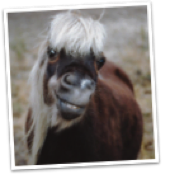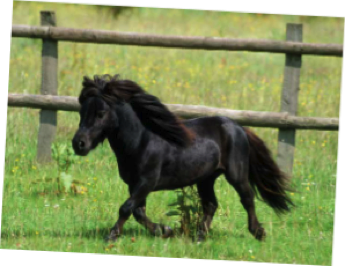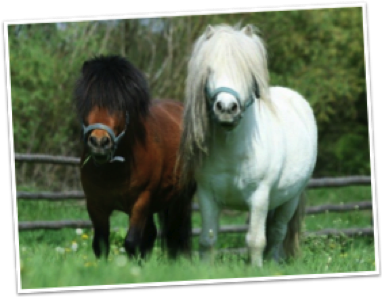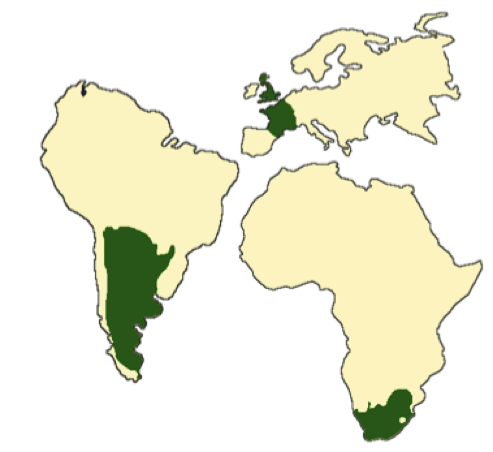
Name: Miniature Horse
Scientific: Equus ferus caballus
Family: Equidae
Relatives: Horse, Donkey, Zebra
Environment: Grassland
Origin: Argentina, United Kingdom,
Life-span: 30 years
Size: 36 inches
About Me
Miniature horses were developed by breeding pony breeds such as the Shetland, Dartmoor, and similar small ponies with full sized horses. To qualify as a miniature horse they must measure less than 38 inches tall at the withers, or top of the shoulder, when fully grown. Though the miniature horse originated from pony breeds, they are considered horses and not ponies because of their common characteristics with full sized horses. Some breed registries prefer that miniature horses have a proportional head, body, and legs; while other registries require more pony-like qualities. They usually have a longer body, big head, and very short legs. There are miniature horses who show signs of dwarfism. These qualities are not ideal and can potentially lead to structural problems for the horse later in life, but even so miniature horses may outlive their full-size cousins.
Miniature horses may live as long as 35 years. They can be very friendly, and make good family pets. Even if they have frequent interaction with humans, it is important to remember that miniature horses are horses. They retain the the same natural instincts, including flight behaviors, and require the same treatment and care as a full-size horse.
Small horses have been found throughout the ages with some of the most famous people in history. Miniature horses were buried in the Pharaoh's tombs in Egypt. In Europe in the 1300s, nobility began keeping small horses to pull carts and as pets. The French King Louis XIV’s records indicate that he had tiny horses in his zoo in the 1650s. During the Renaissance period documentation of what is now known as the miniature horse arose. Even Napoleon III’s Empress wife had a carriage pulled by a miniature horse. By the 1860s another variation of miniature horse called the Falabella miniature horse was created in Argentina by Patrick Newell. His son-in-law Juan Falabella continued the breeding of ponies with small Thoroughbred horses after Patrick Newell’s death. After many generations, they were able to achieve consistency in the small stature of their miniature horses. Lady Estella Hope and her sisters carried on a breeding program from their bloodlines through the mid-nineteen hundreds in England. In 1945, the South American Miniature Horse became another recognized breed with the smallest recorded horse reaching only 26 inches in height.







Fast Facts

Snapshot
1. Miniature horses were found in the tombs of Egyptian Pharaohs.
2. The empress wife of Napoleon III had a miniature horse.
3. The Guide Horse Foundation trains miniature horses for assistance animals.
Miniature Horses and their variations, known as Falabella and South American Miniature Horses, are the smallest equine.
They were developed from many sources and exist in many locations around the world, particularly Europe and the Americas. There are multiple breed registries for miniature horses, each with their own ideal characteristics and breed standards to qualify for registration.
Miniature horses are considered horses, and not ponies because of their shared characteristics with horses.
South Africa




United Kingdom
South Africa
Argentina
Europe
South America
Africa
Draft
Like other miniature animals, the miniature horse is ideal for locations with limited space. Through history, just as now, they were used to pull carts to transport goods or people, and were even ridden. Because of their small stature, miniature horses were ideal for working in confined spaces. They, along with other small ponies, were used to work in coal mines. Their use then spilled into the narrow and crowded streets pulling carts. Though miniature horses may not be able to pull the same amount of weight as their full-size cousins, they posses a fierce determination that makes them very useful.
Assistance
In 1999 the Guide Horse Association was founded to train miniature horses as assistance animals. Though the program is still in the early stages, miniature horses have proven suitable assistance animals for some people with disabilities. The horses’ natural safety instinct to avoid danger helps them to choose safe routes. They have proven successful alternatives for people who are allergic to dogs, or those who require more physical assistance. People whose disability affects their ability to stand up or stabilize themselves find miniature horses helpful as they are very strong and stable.


